Yesterday, we looked at the difference between s-twisted and z-twisted embroidery thread. Today, we’ll look at how the twist affects certain stitches, just so you know that you should be aware of the difference in how z-twisted threads take to certain stitches.
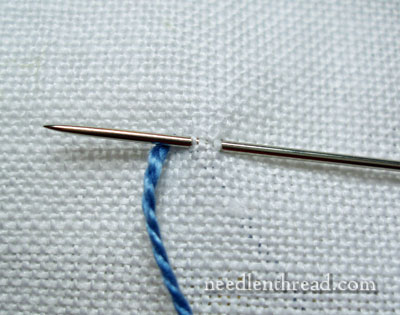
I’m beginning with a #5 perle cotton by DMC, which is an s-twisted thread. Here, I’m starting the stem stitch, working it from left to right with the working thread below the needle.
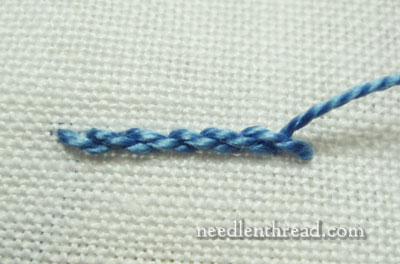
This is what the stem stitch looks like when stitched with an S-twisted thread. Now, keep in mind, this is what stem stitch is supposed to look like. The stitches overlap, they are distinguishable, and the thread maintains its twist – all of which produces the rope-like took of the stem stitch.
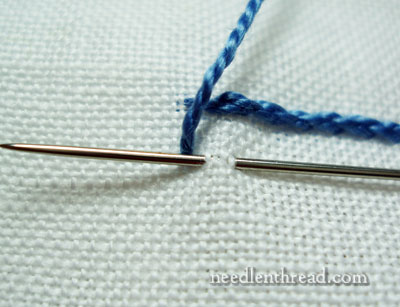
Now, using the same thread – a #5 perle cotton by DMC, which is an s-twisted thread – I’m stitching an outline stitch. The movement of the stitch is the same as the stem stitch, but the working thread, when working from left to right, is kept above the needle.
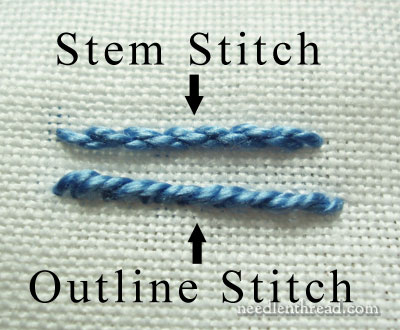
You can see the difference between the stem stitch on the top – which maintains its distinguishable stitches and the twist in the thread – and the outline stitch below, which untwists with the movement of the stitch and doesn’t maintain clearly distinguished stitches.
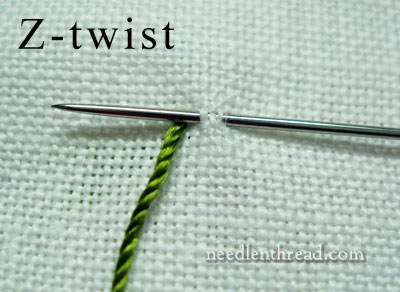
Now, the z-twisted thread. Above, you can see I’m starting the standard movement for the stem stitch – working from left to right, and keeping the working thread below the needle.
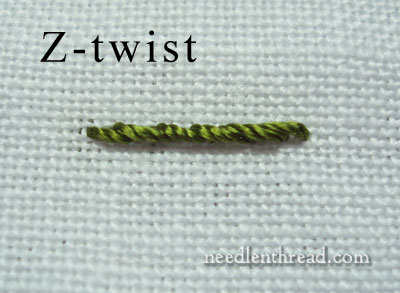
But, look at the outcome. It doesn’t look like a stem stitch, does it?
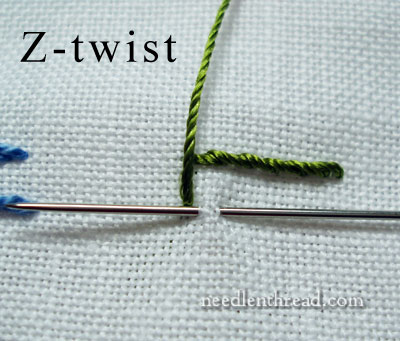
Now, I’m working the outline stitch, working from left to right, with the working thread above the needle.
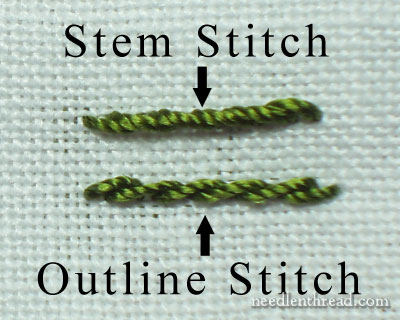
Because the twist of the thread is different, the stem stitch stitched with a z-twisted thread looks like an outline stitch, and the outline stitch looks like a stem stitch.
So here’s a good question: What defines the stitch, the stitch movement or the stitch outcome? If I were looking at the stitches above, without examining the twist of the thread, I would call the top stitch sample outline stitch, and the lower stitch sample stem stitch. Wouldn’t you?
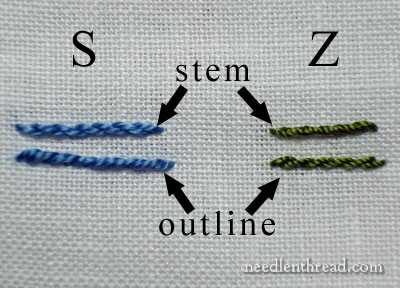
Here you can see them lined up side-by-side, the s-twist on the left and the z-twist on the right.
Now, for practically stitching purposes, here’s the rule: If you are using a z-twisted thread and you want the result of the stitch to look like the result in the instructions you are following, move the thread in the opposite direction, whenever a thread movement is indicated in making a stitch, but go through all other steps the same way. For example, if you are told to stitch from left to right, keeping the thread below the needle, instead you’ll still stitch from left to right, but keep the thread above the needle. If you’re told to twist the thread clockwise, twist it counter-clockwise. The exception for following written instructions would be if you are following instructions written specifically for Brazilian Embroidery. Brazilian Embroidery characteristically uses rayon thread, which is z-twisted.
Finally, the point of this is all rather moot, if you don’t use z-twisted threads. If you use cotton threads exclusively, you don’t have to worry about it! But oh—-!!!!! What a world of threads is out there! And what a world of varied and beautiful results can be had by trying them out!
Any questions? Feel free to leave a comment!







How interesting! Thank you for your very clear explanations. I realize that I have been making two mistakes : not paying attention to the S- or Z-twist (despite the fact that I knew their existence… oops), and not paying attention to the position of the thread below or above the needle. From now on, I’ll be more rigorous in my stiching. Thanks again!
Hi Mary!
What a great lesson in S and Z twists and stem stitch! The photos are so clear – I wish the more of the embroidery stitch books made this difference clear. Thanks so much!
Kathy
S and Z and right and left and above and below all make sense if you stitch right-handed. How is it different for left-handed stitchers? Also, is the old rule about “keep the working thread on the outside of the curve” not right? My stem stitch changes its appearance from time to time. Does the “outside of the curve” rule cause a change from stem to outline?
Hi, All – Thanks for your comments!
Debbie – Whether you’re right or left handed, if you are proceeding from right to left with stem stitch (which is how the left handed stitcher would work, but also the right handed stitcher, if not able to move the frame) then, according to most directions that are written for s-twisted threads, the thread goes above the needle if you’re trying to achieve the stem stitch look. But if you’re stitching with a z-twisted thread, then you apply the rule of changing the direction of the thread movement (mentioned towards the end of the post). If you’re stitching with a z-twisted thread and moving from right to left, and trying to achieve the look of the stem stitch, you’d then keep the thread below the needle, instead of above. Watching the stem stitch video might help clarify the question as well – you’ll see that I address the question of thread placement for lefties as well, in the part of the video where I work across the top of the rectangle, from right to left. And I’m working there with a regular cotton thread, so if I were working with a silk or rayon z-twist, I’d change the placement of the thread in relation to the needle.
Kathy – thanks! For most embroidery restricted to cotton use, the point is pretty much moot, but as the stitcher begins trying out different threads, with the proliferation of specialty threads on the market today, it’s good to know the difference.
Kajin – glad this helps!
thx for this informative post w/photos. it does make a difference!!!
The visuals and explanation made this issue perfectly, absolutely, wonderfully clear!
Oh boy that was quite a lesson – I have to admit I had not ever thought of S and Z threads before but it does make the difference if you want to get the stitch looking as it should and why you may encounter difficulties getting it right – thanks so much for that although it was a bit mind boggling but the diagrams were very clear.
Have a great day – cold again here across the pond!
Luv
El
Great information. Had to show my husband last night since he’s just recently started stitching (cross stitch). To be honest, I didn’t know there was a difference between stem and backstitch. And if most threads are “S”, then backstitch would never work. Would you just do stem stitch all the time to get a pleasing result? I think I would. The finished appearance is what matters most to me even if I have to fudge a bit to get there.
As my mind is twisting I now have a clear understanding of the S and Z stitches. Always wondered about that -‘just sayin
Thankyou
Wonderful! You have completely demystified this for me, Mary. Seeing them side by side was the key. Thank you very much.
That’s really interesting Mary, thank you. Most of my threads are cotton but not all, so I’ll have to take a closer look at them.
I commented on the Dec. 29 blog, recommending a book that compares the thickness of about 1500 threads of all types – cotton, silk, linen, man-made, glitter, etc. It also lists whether each thread is an S or a Z twist. This is very handy for me since I have learnt that I just cannot make needle lace with a Z twist thread. It must be the way that I twist the needle as I make a stitch. I tighten the Z twist so much that I either get knots every second stitch or so or I have to dangle the needle and thread after every stitch. Life is too short for that, so I always check the twist when I choose a thread for needle lace.
See: http://paternoster.orpheusweb.co.uk/threads/threads.html
P.S. I have no connection with the author/publisher. I’m just a very happy customer.
Hi, Margot! Thanks very much for the book recommendation. I will definitely look into it – it sounds like a great reference book to have one hand!
Best regards,
Mary
Who would have known the thread twist direction could make so much difference (well, obviously you knew, but I certainly didn’t!). Now I’m going to pay more attention to my threads.
With cross stitch the issue arises also about the direction of the twist. I like x-stitching from right to left on continuous lines, but I noticed by doing so the thread took an ugly twist whereas when I did it from left to right it remained smooth as a tooth. I thought this had to do with the twist of the floss.
Actually, Brigitte, if you train yourself to hold the needle so that it doesn’t turn – keeping the eye, for example, towards you, whether you’re going up or down in the fabric, you can eliminate the problem with cross stitch and similar up-down type stitches (backstitch, satin stitch, etc.) where each stitch doesn’t interact with the previous stitch.
Lady, you rock! I was looking for something to occupy my impending retirement, and I think I found it… Your tutorials are fantastic. As a beginner, I feel like I found the right place to start. I just signed up for your newsletter and wanted you to know how cool I think you are! Thanks for the support…
Dear Mary,
Thank you for your wonderful and clear explanation. It is extremely useful.
Please keep spreading your knowledge on us, poor layman people.
Kind regards
GB
Wow! This was one of the most interesting posts yet!! Being able to see the stitiching along with your explanation(s) is wonderful. I’m keeping this for future reference. Thanks so much
What a great tutorial. I had never really looked at threads from this point of view but rather look at the finished result. Thanks for all your sharing of information.
I was looking forward to this post. It was Excellent! I haven’t ventured to a variety of threads but if I do the ‘s’ and ‘z’ will not be a puzzle.
Thank you Mary.
And of course this is probably all backwards for us lefthanders!? I can never figure out if I’m doing a stem or outline stitch, since I go from right to left. Sigh.
Hi, Linda – there’s some explanation up above in my (very long!) previous comment about left hand / right hand stitching. It will also help to watch the stem stitch video, which addresses the left-handed question.
Any hints for left handed stitchers. I avoid using Perle Cotton because it always untwists. I follow right handed instructions because when I learned there were no left handed instructions available that I was aware of.
What is the best left handed book available in your opinion.
Joan, the best left-handed book is Yvette Stanton’s – it’s excellent! ~MC
Beautifully clear! Thank you.
Wow!!! What a difference it makes!!! Thanks for showing us!!!
Thank you, Mary, for the graphic and pictorial description of s and z twistet threads. I did not know this info. It certainly will help me when I do the stem stitch from now on.
Dear Mary,
I was very interested to read your article regarding S and Z twist threads. As a business that specialises in Brazilian Dimensional Embroidery (using predominately Z twist threads) this subject is addressed constantly in our books and instructions. Your article was excellent, very clear – Congratulations. Have you looked at Brazilian Dimensional embroidery in the past?
Regards, Delma
Thanks Mary. Terrific tutorial. I am also somewhat obsessed with my threads. Your question about defining the stitch got me thinking. I think you have to define the stitch based on the stitch movement or it would be much too difficult to teach new stitches. Once a stitcher gains experience then the outcome would become more important and stitches could be adjusted to affect it.
Now here’s a question: How does flat silk affect these stitches? I would think it shouldn’t have an effect on the outcome based on which way the thread lays, but would something like a stem stitch even look nice done with flat silk given it doesn’t have a twist? It’s something I might have to try.
Hand spinners are well aware of Z twist and S twist. If you have just one ply in your spun thread, it will twist or pull your knitted item to one side or the other. That is why spinners strive for a balanced thread or yarn. We spin either twist and ply in the other. I just never gave a thought to it affecting embroidery but of course it would considering it is also spun. Thank you for pointing this out
Thank you! I have always mentally dismissed any suggestion that outline and stem stitch were different since they were clearly simple mirror-images of each other. But since the thread has a “handedness”, it actually does make a difference, as your pictures so clearly show. Now I need to pick up my threads and see if this is why I’ve been hating my stem-stitch results with perle cotton. Cool!
Which is to say, perhaps I’ve actually been doing outline and not stem stitch, since I didn’t think there was a difference and was ignoring those details.
I am amazed at the difference in the examples. To me the final outcome is what is important and what you should base stitch choice on. Thank you for showing us the difference the thread makes. Now if something doesn’t look as we think it should we have this for consideration.
Debbie
Very informative. Thanks
Mary, how does it affect a left handed person’s stitching?
I am actually a rightie, but do all fine motor skils left handed (holding needle, scissors, etc.)
Sometimes I think I stitch like a leftie but in the same way a rightie does. I don’t change directions.
I write right handed as my legal signature, but can write properly left handed, as well. As far as I know, my being ambidextrous is an amazing gift.
Golf as a right hander, Bowl as a left hander. LOL
Hi, Marny! I’ve addressed the left-handed question in some of the previous comments on the post, if you want to take a look at them. You might also want to watch the stem stitch video, as it addresses the question as well! Hope that helps!
Thanks, Wendy! 🙂
Heidi & Susanne – I’m glad it helps!
~MC
I feel so much more informed now. I love the stem stitch too and could see the difference between that and the outline but now I know why. Thanks.
Thanks for the info Mary! I have been asking this question for years and no one understood what I was asking specifically. I knew the twist would affect the stitches and wondered whether I should be fixated on the look of the stitch or the technique. I am with you, the look of the stitch is what we are after and have to assume that the fibers we use are essentially standard “S twist”. If I find myself using a “Z twist” and the stitch called for is stem stitch, I will perform the outline stitch technique. Again, thanks for clarifying a nagging question I have kept in my stash for years.
Hi Mary-
Thanks so much for the timely information on S vs Z twists – I want to recreate some embroideries from my grandmother’s house, which were stitched in the 40’s using a shiny thread no longer available. My local needlework shop buddy suggested rayon thread, and having never used a Z-twist thread, you have saved me much frustration and frog stitching!
Tricia
Thanks so much Mary! Your instructions and explanations are always so clear! The video for this stitch is really helpful since I will be using the stem stitch north-south. I`m printing out this page and tucking it in with my sampler pattern…You are the best!
My newest love is Brazilian Embroidery so I read your comparison of the s twisted and z twisted thread with great interest. Good job. Some day I would like to do a small piece using both types of thread. This information is invaluable towards that goal.
Thanks so much for this information. I didn’t even realize the difference in the two stitches, much less how the twist of the thread affects the stitches. I love BE and “regular” embroidery and sometimes interchange threads, depending on the look I want. This information is invaluable.
Genie
MARIA:esto es algo en que nunca habia pensado,ni sabia que los resultados serian difentes solo por la torsion o posicion ,gracias.
Thank you for your help with the left – handed ‘thing’! I was embroidering over the weekend, and I really could see a difference!
In(India)in which company threads i will get Z twist thread for brazilian embroidery
Thank you very much for explain and excellents photos.
Have a good day and God bless you.
Sonia
Your demos on the s and z twisted thread is great!! Is there a list somewhere of common threads showing which are s twisted or z twisted?
It would help, us stitchers. Beth Jensen
When stitching on Canvas, how do you keep the S twist Pearl Cottons to remain uniform? They tend to “Untwist” themselves. I fight with twisting it back but then sometimes it is to much. Any suggestions?
Hi, Tracy – the key is to try (the operative word is “try” – I find this difficult to do until I practice a bit!) to avoid turning your needle as you stitch. If you keep the eye of your needle always facing towards you, and you don’t twist the needle with every stitch, you’ll have better luck untwisting the thread as you stitch. Most stitchers, when working surface embroidery, tend to twist up their threads too much, rather than untwist them. But when working needlepoint, it’s just as easy to over-twist as it is to untwist. Another option: every few stitches, roll your needle between your thumb and finger the direction that adds a little twist to your thread. This way, you’ll work against untwisting it. It’s something that takes concentrating on, until you get used to stitching either without turning your needle and untwisting the thread, or habitually adding some twist to your thread.
~MC
Hi, I have bought some rayon embroidery thread with the intention of crocheting or braiding with it. I have been unable to get several strands to twist together and stay together. Any ideas how this can be done?
Mary, the final photo in your tutorial, where you compare the two different stitches, using different threads, is not mis-labeled, but the text has it reversed. May I suggest, and please excuse me here, that you could make a new sample, with S-twist on the right, because it is right-twist, and Z-twist on the left, since it is left-twist. That would make it easier to remember, and would match the comments. As a matter of interest, I have been researching left-twist versus right-twist for some time now, and have found conflicting explanations, errors in diagrams, and general confusion. Even my Bernina manual said “Take a piece of thread in both hands, and roll it toward you with one thumb. Left-twist thread will tighten, right-twist loosen.” But it did not state which thumb to use. I know now that the author meant “with your right thumb”, but I did not know it then, and was upset with Bernina when I first read that. I did enjoy your lesson, though I haven’t done any embroidery. Just learning to mend my shirts, and have made a few using Vogue patterns. Now I can’t stand to wear cheap shirts!
Thanks, Jim – I corrected the text. Got my left and right mixed up there. Thank you!
In my previous article (previous to this one), I show the two twists up close and how to determine at a glance which is which. I prefer being able to tell by looking at the thread, rather than by the rolling trick – it’s a lot less complicated, especially for newbies.
Thanks again for catching that!
MC
Love your site!
I plan to spin some thread/yarn for embroidery, but I didn’t know which direction it need to be.
Thanks for the rescue!
Thanks for this tutorial. It was really helpful for my current project, the first time I’d ever done stem stitch. I’m very glad I’d bookmarked this post for reference, since I was using Z-twist silks.
Since I’m left handed and tend to reorient my canvas frequently for convenience, remembering how to vary the stem stitch based on which way I’m going and what thread is hard. But when I experimented, the difference between outline and stem stitch (by appearance, anyway) turns out to be really simple.
Basically, stem/outline stitch have a slight slant created by the method of working: \ if the working thread stays below the needle, and / if it stays above the needle. The thread twist also creates a slant: / for S-twist and \ for Z-twist.
The stitch looks ropy (like stem stitch) when the two slants are go in opposite directions, and smooth (like outline stitch) when the two slants are parallel. It’s easier for me to remember this and then figure out the exact method of work on the fly than memorize all the variants.
Try embroidergwithflowerdesigns tanky
Any thoughts about why Japanese Embroidery mostly uses Z twist? We do twist with our right hand on top, and left hand on the bottom; does that have an impact, since we’ll then generally work from the left to the right hand side of the piece (since our right arm/hand is thus lying on top)?
Christine
Thank you Mary that was so informative. As a novice (2 months) embroiderer I was somewhat confused. A shop is closing in our town and I picked up some bargain Stranded Cotton for AU$1.00 (nearly half price) so after a gleeful time I came home and set out all my new cotton on the table and just sat and ‘looked’ at all those lovely colours, ooh aah. Just finished my 1st project, talk about addictive and soothing, feel quite chuffed with the result. Again, thanks Mary really enjoy your site.
This is most clear resource I’ve seen showing the effects of s and z twist and how to deal with it. Thanks.
What if you are left handed and stitch right to left not left to right? How does that affect the stitches?
Hi, Ilene – it depends on the stitch. With stitches like stem stitch, it makes a difference. With other stitches like backstitch or chain stitch, it doesn’t.
Mary, Thank you so much for the clear, helpful lessons. I am a passionate quilter but have been adding some embroidery details to some projects. I just completed Xmas stockings and was following your instructions for stem stitch to do the names- and found myself moving the thread above the needle when going around a curve. I was puzzled as to why the stitches looked so different- now I know. I will try your suggestion of taking smaller stitches around the curves. I have been enjoying your blog as well – even tho I do very little embroidery……..maybe one day. Karen
Great tutorial! I was just wondering though, can’t you just turn your z twist thread upside down to make it s twist?
It doesn’t matter what direction you arrange a thread in – it’s always z twist or it’s always s twist, no matter what direction you turn it. If you look at a piece of thread close up and try manipulating it different directions, you’ll see what I mean.
Bravo. You defined the challenge that we Brazilian Embroiders face with Z twist threads beautifully. I have done Brazilian embroidery for over thirty three years. This is the first time I have seen it described in a simple, yet thorough manner.
I always turn to your website for information and you never fail to simplify my my delema.
I was taught to sew and embroider when I was very small. It has remained a love of mine ever since. I have beautiful memories of sitting beside my mother stitching together. That was over seventy years ago .
That’s a lovely story!
Does it matter if you are left handed- you are stitching the opposite direction. After you cut the thread, does it matter which end of the thread is threaded (or knotted).
On some stitches (like stem stitch) it does matter.
No, a thread is z twisted or s twisted, no matter which end of it you are looking at. Turning the thread around doesn’t change the twist.
Fascinating! I LOVE articles like these!
This is so interesting! I was very puzzled because I couldn’t understand why the stem stitch and the outline stitch look so different just by holding the loop above or below, now this makes perfect sense. I know this is an old post, but it’s been very useful, thanks!
I did not know this, thanks!
If I join the Patreon thing is that a monthly charge or can I pay for one year at a time?
Hi, Ginny – At this time, my Patreon membership is set up on a monthly basis. Thanks for asking!
I am sorry but this is so confusing. You say that for the Z-twist thread the outline stitch looks like a stem stitch, and vice versa, but you don’t say which position of the working thread is best for each stitch. Please confirm, is this right?
For a Z twist thread doing the outline stitch, keep the thread below the needle
For a Z twist thread doing the stem stitch, keep the thread above the needle
For an S twist thread doing the outline stitch, keep the thread above the needle
For an S twist thread doing the stem stitch, keep the thread below the needle.
Thank you so much for the wonderful blog, and for clearing up my confusion 🙂
Susan James
Yes, that’s correct.
In most cases of written or diagramed instructions, they are written or diagramed for s-twisted threads (unless you happen to have a book on Brazilian embroidery, which employs rayons, which are normally z-twisted). So if you’re working with a z-twisted thread while following a typical stitch dictionary published today, and you’re working a stitch that will be affected by the twist (stem, buttonhole, outline, and any similar stitch that results in a rope-like line or edge to the stitch) you’d just reverse the location of the working thread in relation to the needle.
I am trying to learn whatever is necessary to become a better embroidered. I am retired and stitch almost every day. Your article on S and Z twist was something I never heard of before. Can you recommend what I should do to continue to advance in my understanding of embroidery. I live in Hawaii so that somewhat restricts me to online learning.
I think the best thing is to practice! Find a project that you like and delve in. The more you do it, the better you’ll get!